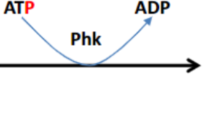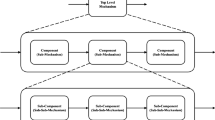Abstract
In this paper, I critique two conceptions of mechanisms, namely those put forth by Stuart Glennan (Erkenntnis 44:49–71, 1996; Philosophy of Science 69:S342–S353, 2002) and Machamer et al. (Philosophy of Science 67:1–25, 2000). Glennan’s conception, I argue, cannot account for mechanisms involving negative causation because of its interactionist posture. MDC’s view encounters the same problem due to its reificatory conception of activities—this conception, I argue, entails an onerous commitment to ontological dualism. In the place of Glennan and MDC, I propose a “modified conception” of mechanisms, which (a) obviates the problem of negative causation by reinterpreting MDC’s activities according to a “descriptivist” account, and (b) avoids MDC’s problem by postulating a monistic ontology of entities. Thus, by solving these problems, my modified conception offers a cogent, more adequate alternative to Glennan’s and MDC’s conceptions of mechanisms.



Similar content being viewed by others
Notes
See Pietroski and Rey (1995).
I do not discuss William Bechtel’s parts/operations conception in this paper, although it is, at least in certain respects, very similar to the modified conception that I enunciate in Sect. 5.
See Pietroski and Rey (1995) for discussion.
Incidentally, Woodward argues that the dichotomy between laws and accidental generalizations is spurious and ought to be abandoned.
As Craver points out, the use of variables as causal relata is advantageous because a wide variety of possible relata—events, processes, objects, etc.—can be converted “without loss” into talk of variables (Craver 2007a, p. 95).
I follow Craver in understanding causal relata as contrasts, and thus the adicity of causal relations to be four (Craver 2007a, pp. 82–83).
Personal communication.
As I suggest below, Glennan (2002) appears to renounce his 1996 anti-fundamentalism about causation by adopting Woodward’s manipulability theory of causation, although the two are not necessarily incompatible.
As I discuss below, following Craver I consider instances of inhibition to be negative causes. Indeed, inhibition, in contrast to “omission,” falls within the category of “prevention.” Prevention occurs when C causes not-E; not-E in turn is identical to not-C that causes E. In this way, inhibition is causally negative. Neural networks exhibit inhibition when one neuron hyperpolarizes another, thereby preventing it from firing. See Craver (2007a, pp. 6, 80–81) for more.
Lindley Darden (personal communication) argues that MDC’s conception can account for cyclical mechanisms. The only difference between these and linear mechanisms is that one must more or less arbitrarily select start and termination conditions, e.g., the Krebs cycle starts with isocitrate rather than α-ketoglutarate, or succinate rather than fumarate.
Craver similarly characterizes his project in Explaining the Brain as consisting of a descriptive, and then normative step (Craver 2007a, p. viii).
Lindley Darden envisages a “completely static” and “frozen world” without activities (Darden 2006, p. 278; see footnote).
Machamer states in the very next sentence: “This is the dualistic position that [MDC] put forth” (Machamer 2002).
There is considerable confusion among philosophers about the ontological status of MDC’s activities. Many seem to think, like Tabery, that activities do not constitute a distinct ontological category. This is simply false, as both careful readings of MDC’s paper and personal communication with its authors verify. Indeed, as Darden puts it in personal communication, MDC’s dualism is a radical break from the inveterate tradition of substantivalism.
Although activities are slightly different in character than processes, the former is derivative of the latter.
This has been confirmed through personal communication. The idea, I think, was to disencumber the notion of causation from the heavy connotations (and whatever other semantic baggage) that the term carries with it, and to do this by introducing into the philosophical lexicon a novel term.
MDC would agree, I think, that their dualist ontology is “onerous.” Indeed, this is precisely why they feel the need, as they say, to “justify this break with parsimony, this dualism of entities and activities” (MDC 2000, p. 4; emphasis added), by arguing for their conception’s ontic, descriptive, and epistemic adequacy.
Spontaneous processes may result not just from negative causes (such as in LTP), but also from positive causes; for example, the presence of salt may be responsible for the entropic movement of water across a cell membrane.
To be clear, even in the case described in footnote 15, there still would be no interaction between the salt and the water.
Darden says essentially the same thing: “Interaction between two entities is a kind of activity, conceived in a more entity-centered way and missing the productive nature of activities in general” (Darden 2006, p. 277; my emphasis). Although I disagree with the second statement that interactions miss the productive nature of activities (see Sects. 2 and 5), Darden and I concur that interactions are a subset of activities. Furthermore, an etymological parsing of ‘interaction’ corroborates my contention: ‘inter-’ meaning between and ‘action’ or activity.
This interpretation is similar in many respects to Craver’s “deflationary” view of activities (Craver 2007b).
See Craver (2007a) for discussion about mechanism levels.
That is, understood as reified causes.
As Tabery (2004) indicates, Machamer first suggested the term.
I obviate this category mistake with my descriptivist interpretation of activities, which explicitly relieves activities of their ontological baggage.
I thank an anonymous referee for this example.
The term ‘direct’ here simply signifies that there is no intervening activity on that mechanism level between an entity and its behavior or two entities and their interaction.
See Craver (2007a, p. 82), for a more detailed analysis.
‘Genuinism’ is Phil Dowe’s coinage (Dowe 2004).
Note that Craver also discusses inhibition as negative causation (Craver 2007a, pp. 6, 81).
References
Bechtel, W. (2006). Discovering cell mechanisms: The creation of modern cell biology. Cambridge: Cambridge University Press.
Bechtel, W., & Richardson, R. (1993). Discovering complexity: Decomposition and localization as strategies in scientific research. Princeton: Princeton University Press.
Bogen, J. (2004). Analysing causality: The opposite of counterfactual is factual. International Studies in the Philosophy of Science, 18, 3–26.
Bogen, J. (2008). Causally productive activities. Studies in History and Philosophy of Science, 39, 112–123.
Craver, C. F. (2006). When mechanistic models explain. Synthese, 153, 355–376.
Craver, C. F. (2007a). Explaining the brain: Mechanisms and the mosaic unity of neuroscience. Oxford: Oxford University Press.
Craver, C. F. (2007b). Activities and causal relevance, presented at Mechanisms and Causation. University of Maryland, College Park.
Darden, L. (1991). Theory change in science: Strategies from Mendelian genetics. New York: Oxford University Press.
Darden, L. (2002). Strategies for discovering mechanisms: Schema instantiation, modular subassembly, forward/backward chaining. Philosophy of Science, 69, S354–S365.
Darden, L. (2006). Reasoning in biological discoveries. Cambridge: Cambridge University Press.
Darden, L., & Craver, C. (2002). Strategies in the interfield discovery of the mechanism of protein synthesis. Studies in the History and Philosophy of the Biological and Biomedical Sciences, 33, 1–28.
Dowe, P. (2004). Causes are physically connected to their effects: Why preventers and omissions are not causes. In C. Hitchcock (Ed.), Contemporary debates in philosophy of science (pp. 189–196). Oxford: Blackwell.
Glennan, S. (1996). Mechanisms and the nature of causation. Erkenntnis, 44, 49–71.
Glennan, S. (1997). Capacities, universality and singularity. Philosophy of Science, 64, 605–626.
Glennan, S. (2002). Rethinking mechanistic explanation. Philosophy of Science, 69, S342–S353.
Hume, D. (2006). An enquiry concerning human understanding. New York: Oxford University Press.
Machamer, P. (2002). Activities and causation, Philosophy of Science Association (PSA), 18th Biennial Meeting: Contributed Papers (Milwaukee, WI; 2002): PSA 2002 Workshops. http://philsci-archive.pitt.edu/archive/00000864/.
Machamer, P. (2004). Activities and causation: The metaphysics and epistemology of mechanisms. International Studies in the Philosophy of Science, 18, 27–39.
Machamer, P., Darden, L., & Craver, C. (2000). Thinking about mechanisms. Philosophy of Science, 67, 1–25.
Morris, W. E. (2008). David Hume, The Stanford Encyclopedia of Philosophy (Fall 2008 Edition), E. N. Zalta (ed.), http://plato.stanford.edu/archives/fall2008/entries/hume/.
Pietroski, P., & Rey, G. (1995). When other things aren’t equal: Saving Ceteris Paribus laws from vacuity. The British Journal for the Philosophy of Science, 46, 81–110.
Purves, D., Augustine, G. J., Fitzpatrick, D., Hall, W. C., LaMantia, A. S., McNamara, J. O., et al. (2004). Neuroscience. Sunderland, MA: Sinauer Associates, Inc.
Quine, W. V., & Ullian, J. S. (1978). The Web of Belief (2nd ed.). McGraw-Hill Humanities/Social Sciences/Languages.
Rescher, N. (1996). Process metaphysics: An introduction to process philosophy. New-York: State University of New York Press.
Rescher, N. (2002). Process philosophy, The Stanford Encyclopedia of Philosophy (Summer 2002 Edition), E. N. Zalta (ed.), http://plato.stanford.edu/archives/sum2002/entries/process-philosophy/.
Rey, G. (1997). Contemporary philosophy of mind: A contentiously classical approach. Oxford: Blackwell.
Salmon, W. (1984a). Scientific explanation and the causal structure of the world. Princeton: Princeton University Press.
Salmon, W. (1984b). Scientific explanation: Three basic conceptions. In PSA: Proceedings of the Biennial Meeting of the Philosophy of Science, pp. 293–305.
Salmon, W. (1994). Causality without counterfactuals. Philosophy of Science, 61, 297–312.
Schaffer, J. (2003). Metaphysics of causation, The Stanford Encyclopedia of Philosophy (Winter 2007 Edition), E. N. Zalta (ed.), forthcoming http://plato.stanford.edu/archives/win2007/entries/causation-metaphysics/.
Schaffer, J. (2005). Contrastive causation. Philosophical Review, 114, 297–328.
Skipper, R. A., & Millstein, R. L. (2005). Thinking about evolutionary mechanisms: Natural selection. Studies in History and Philosophy of Biological and Biomedical Sciences, 36, 327–347.
Tabery, J. (2004). Synthesizing activities and interactions in the concept of a mechanism. Philosophy of Science, 71, 1–15.
Thagard, P. (2006). What is a medical theory? In R. Paton & L. A. McNamara (Eds.), Multidisciplinary approaches to theory in medicine (pp. 47–62). Amsterdam: Elsevier.
Woodward, J. (2000). Explanation and invariance in the special sciences. British Journal for the Philosophy of Science, 51, 197–254.
Woodward, J. (2001). Law and explanation in biology: Invariance is the kind of stability that matters. Philosophy of Science, 68, 1–20.
Woodward, J. (2002). What is a mechanism? A counterfactual account. Philosophy of Science (Suppl.), 69, S366–S377.
Acknowledgements
I would like to thank an anonymous referee, Stuart Glennan, Christopher Cherniak, Mathias Frisch and Carl Craver for helpful feedback. Special thanks to Lindley Darden for many insightful comments on earlier drafts.
Author information
Authors and Affiliations
Corresponding author
Rights and permissions
About this article
Cite this article
Torres, P.J. A Modified Conception of Mechanisms. Erkenn 71, 233–251 (2009). https://doi.org/10.1007/s10670-008-9125-y
Received:
Accepted:
Published:
Issue Date:
DOI: https://doi.org/10.1007/s10670-008-9125-y




